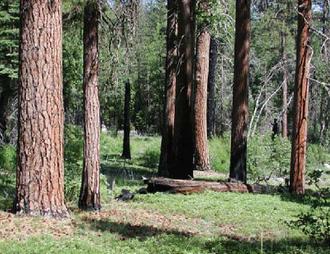Large Tree Loss in Yosemite National Park Linked to Climate Change
YOSEMITE NATIONAL PARK, California, July 30, 2009 (ENS) - There are fewer large-diameter trees in Yosemite National Park today than there were in 1932, and warmer climate conditions have played a role in this decline, new research by government and university scientists shows. Large diameter trees are those that have lived the longest, often called old-growth trees.
Their new research paper carries a warning that more frequent and severe wildfires are possible in Yosemite due to the warming climate and a shift to fire-intolerant tree species.
U.S. Geological Survey and University of Washington scientists compared the earliest records of large-diameter tree densities from 19321936 to the most recent records from 19881999. They documented a decline of 24 percent in the number of large-diameter trees in the park over this 67 year time period.
"Although this study did not investigate the causes of decline, climate change is a likely contributor to these events and should be taken into consideration, said USGS scientist emeritus Jan van Wagtendonk.
 |
A stand of trees in Yosemite National Park unburned since 1936. (Photographed 2008 by J.A. Lutz) |
"Warmer conditions increase the length of the summer dry season and decrease the snowpack that provides much of the water for the growing season. A longer summer dry season can also reduce tree growth and vigor, and can reduce trees ability to resist insects and pathogens, said van Wagtendonk, who is based at the U.S. Geological Survey Western Ecological Research Center, Yosemite Field Station.
In their paper, published in the journal "Forest Ecology and Management," the authors state, "Our strong inference from this research is that the largest trees of most species in Yosemite are in decline. This decrease in large diameter tree density throughout much of Yosemite can be interpreted as a long-term change in forest structure during the 20th century."
Created in 1890 and designated a UNESCO World Heritage Site in 1984, Yosemite National Park is known for its granite cliffs, waterfalls, giant sequoia groves and biological diversity.
But the researchers say a decline in the park's large trees means habitat loss and possible reduction in species such as spotted owls, mosses, and orchids as well as a mammal species known as fisher, which despite its name, seldom eats fish. The fisher, Martes pennanti, is a marten, a carnivore in the weasel family.
The authors explain in their paper that large trees generally have lower rates of mortality than small trees and are more resilient to climate change, but these assumptions have rarely been examined in long-term studies.
For this study, they combined data from 655 historical (19321936) and 210 modern (19881999) vegetation plots to examine changes in density of large-diameter trees in Yosemite National Park, which covers an area of 1,169 square miles.
"We tested the assumption of stability for large-diameter trees, as both individual species and communities of large-diameter trees," they write.
 |
A stand in Yosemite that was burned in 1978 by a prescribed fire and again in 1996 by a wildfire. (Photographed 2007 by J.W. van Wagtendonk) |
They found that large-diameter tree densities as well as diversity declined most in the more extensive higher elevation forest types.
"Between the 1930s and 1990s, large-diameter tree density in Yosemite declined 24 percent. Although the decrease was apparent in all forest types, declines were greatest in subalpine and upper montane forests (57 percent of park area), and least in lower montane forests (15.3 percent of park area).
Large-diameter tree densities of 11 species declined while only three species increased, they found.
Fewer new trees will grow in the landscape because there are fewer large trees to serve as seed sources, the scientists predict.
"Large-diameter trees generally resist fire more than small-diameter trees, so fewer large trees could also slow forest regeneration after fires," they write.
The scientists also found a shift to fire-intolerant trees in some forests that had not experienced fires for nearly a century. In these areas, trees changed from fire-tolerant ponderosa pines to fire-intolerant white fir and incense cedar. In burned areas, pines remained dominant.
In the lower montane Ponderosa pine and California incense cedar forests, where there was less decrease in overall large-diameter tree densities," the authors found that, "large-diameter tree composition differed between stands where fire had been excluded and those that had experienced fire."
Plots that had experienced fire in the 20th century retained large-diameter Ponderosa pine, but plots not experiencing 20th century fire had almost no large-diameter Ponderosa pines, the researchers found.
"This contrast in composition reinforces the management objective of reintroducing fire to these forests," they advise.
On the other hand, Van Wagtendonk warns, "We should be aware that more frequent and severe wildfires are possible in Yosemite because of the recent shift to fire-intolerant trees in unburned areas and warmer climates bring drier conditions."
Copyright Environment News Service (ENS) 2009. All rights reserved.
To subscribe or visit go to: http://www.ens-newswire.com